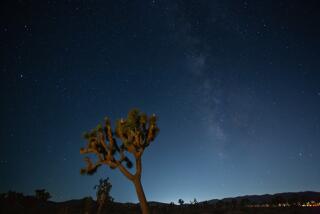Trail-Hiking Students Track the Secrets of Nature--and of How to Write About It
As the students hiked into the Santa Monica Mountains toward Eagle Rock, they stopped to study the rocks, the clouds and a horned lizard, the size of a quarter, that could have starred in a movie called “Honey, I Shrunk the Stegosaurus.”
From time to time, a student dropped behind, pulled a journal from pocket or backpack and scribbled a paragraph or two. One student wrote a mini-essay about life and death, inspired by a patch of dead buckwheat. Another noted that the mountain trail was “as wide as a spare rib.”
The 16 students were taking an unusual course being offered for the first time this summer by Santa Monica College. Called “Writing About Nature,” the double-credit course is an introduction to physical geography and a beginning composition course. Taught by geographer Bill Selby and poet Jim Krusoe, it requires students to learn how to use both a sling psychrometer and a simile. Those who succeed get credit for both Geography 1 and English 1.
Although the teachers’ disciplines diverge dramatically, Selby and Krusoe say they have a common goal--to teach students to observe closely and to record their observations with precision. “So many of our students have lost the ability to observe things that aren’t fed to them,” Selby said. “You have to be a good observer to be a great writer, and there’s never been a great scientist who wasn’t a great observer.”
During the six-week course, the students learn something about maps, weather and climate, geology and the plants and animals of Southern California. They work their way through a text called “Modern Physical Geography.” Classroom lessons are supplemented with a weekly field trip, such as the recent hike to Eagle Rock in Topanga State Park. As the students are learning what an inversion is they are also studying nature writing and learning how to string together their own words about the natural world.
“Essentially, they have to learn to write in six weeks,” Krusoe said. “It’s a killer.”
Krusoe exposes the students to model nature writers as disparate as Romantic poet William Wordsworth and contemporary environmental activist Edward Abbey. According to Krusoe, Sue Hubbell’s book, “Country Year,” is especially useful to beginning nature writers.
In critiquing students’ journal entries, Krusoe is quick to praise evidence that they are paying close attention, whether observing an alligator lizard barely visible in the dust or a distant cluster of homes that looks like a beehive when viewed from the mountains. “The funny thing about paying attention,” he told his students, as they perched on Eagle Rock, moments after displacing a raven, “is that when you really see something, sometimes it’s even better than just using your imagination.”
Krusoe said students tend to “get too pretty” when they begin to write about storm clouds and life cycles. Krusoe’s reading assignments for the course are examples of writing about nature without verbal genuflection. The assigned writers have “natural voices,” he said.
As a geographer, Selby said he is repeatedly shocked and saddened at the lack of widespread knowledge about weather, the rock cycle and other natural phenomena. “It’s scary to know that so many people know so little about the world we live in,” he said.
Resting with the students on Eagle Rock, Selby talked about the materials that formed the outcropping and the natural forces that created it. Geology lessons are much more vivid in the wild than in the classroom. “You can’t stand here and see the rock cycle, but you get a feeling for how the rock cycle is changing the landscape,” Selby said.
Evelyn Batiste, 26, said she had taken the course to fulfill a science requirement and because she thought she would benefit from the writing component. After the first class, the Inglewood woman recalled, she was able to identify the stone in the campus parking lot as shale.
More to Read
Sign up for The Wild
We’ll help you find the best places to hike, bike and run, as well as the perfect silent spots for meditation and yoga.
You may occasionally receive promotional content from the Los Angeles Times.






